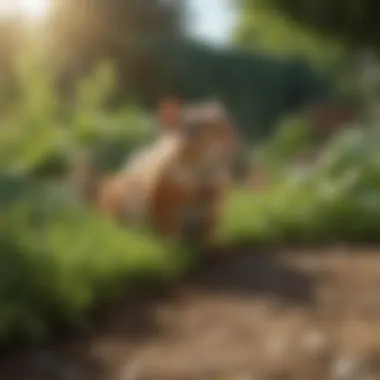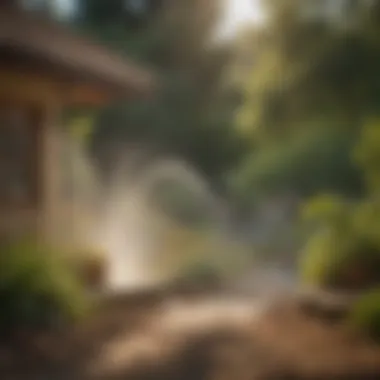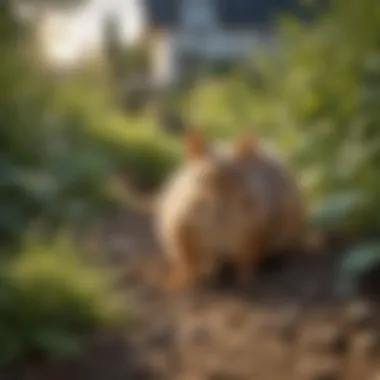Smart Strategies to Keep Chipmunks Away from Your Garden


Intro
Chipmunks, while often perceived as playful creatures, can quickly become a nuisance for homeowners and garden enthusiasts. Their natural behavior leads them to invade gardens, disrupting plant growth and potentially damaging crops. Understanding the strategies to discourage these persistent rodents is essential for maintaining a healthy outdoor space. This article provides a comprehensive guide that details effective methods for preventing and controlling chipmunk populations. By exploring eco-friendly solutions, we aim to enhance your gardening experience while promoting sustainable practices.
Understanding Pests
Definition of Pests
Pests are any organisms that pose a threat to human activity, particularly in agriculture and landscaping. This includes insects, rodents, and other animals that can damage crops or disrupt the maintenance of properties. Chipmunks, as small rodents, fall under this definition. They are known for their agility and ability to adapt to various environments, which makes them formidable intruders in gardens.
Importance of Pest Identification
Identifying pests is crucial for implementing effective control strategies. Knowing the specific type of pest can help in tailoring your approach toward management. Chipmunks are distinct in their behaviors; they dig burrows, hoard food, and often consume seeds and young plants. Recognizing their presence early on allows homeowners to adopt proactive measures, rather than reactive ones. Inefficient pest management can lead to increased damage and higher costs.
Prevention Techniques
Home and Garden Preventative Measures
There are several effective prevention techniques that can discourage chipmunks from invading your yard:
- Secure Garbage: Ensure trash cans are covered and compost piles are managed well.
- Fencing: Install a fence around gardens, buried several inches underground to prevent burrowing.
- Remove Debris: Clear away rocks, wood, and other debris that may provide shelter for chipmunks.
- Plant Selection: Choose plants that are less appealing to chipmunks, such as herbs.
- Water Sources: Eliminate standing water that may attract rodents.
By implementing these measures, homeowners can create an environment that is less hospitable to chipmunks.
Seasonal Prevention Tips
The changing seasons can influence chipmunk behavior. Thus, adjusting preventative measures throughout the year is essential. In spring and summer, focus on maintaining cleanliness in gardens. In the fall, when chipmunks prepare for winter, reinforce barriers and consider repellents to deter them.
Eco-Friendly Pest Control Solutions
Overview of Sustainable Practices
With growing concerns over environmental impact, adopting sustainable practices in pest control is crucial. This includes using natural deterrents rather than chemicals that may harm beneficial wildlife or the ecosystem. By employing eco-friendly strategies, homeowners can combat chipmunks effectively while preserving their environment.
Natural Remedies and Their Effectiveness
Several natural remedies can be useful in deterring chipmunks, including:
- Peppermint Oil: Diluted peppermint oil can deter rodents due to its strong scent.
- Cayenne Pepper: Sprinkling cayenne pepper around plants can repel chipmunks.
- Garlic Spray: A mixture of garlic and water can serve as a natural repellent.
These remedies are not only effective but also safe for gardens, promoting a harmonious balance in your outdoor ecosystem.
"Implementing preventive measures and eco-friendly solutions is essential for maintaining a chipmunk-free garden, ensuring that your outdoor space remains vibrant and healthy."
By understanding the behavior of chipmunks and actively pursuing strategies to discourage them, homeowners can enjoy a more secure and fruitful gardening experience.
Understanding Chipmunks
Understanding chipmunks is a vital component for anyone looking to manage these rodents effectively. Chipmunks are not just common visitors in gardens; they can cause significant damage to plants, flowers, and even the structure of homes. Learning about their behavior, habitat, and eating habits can aid in crafting effective strategies to deter them.
The first step in discouraging chipmunks is recognizing their species and understanding their preferences. Knowledge of their characteristics allows homeowners to create a less inviting space for these animals. Moreover, understanding the periods of their activity helps in timing preventive measures accurately.
A deeper understanding of the chipmunk’s habits can help identify specific behaviors that attract them to particular areas. Effective deterrence requires attention not only to the animals themselves but also to broader environmental factors. Therefore, knowing what draws chipmunks in is critical to developing informed and efficient strategies.
Species Identification
Chipmunks belong to the Sciuridae family, widely recognized for their striped backs. The Eastern chipmunk, Tamias striatus, is the most common species found across North America. It is small, typically measuring 9 to 10 inches in length, and weighs around 3 to 4 ounces. Its distinctive stripes run down its back, giving it recognizable appearance.
Other species include the Yellow-pine chipmunk and the Siberian chipmunk, although their habitats vary significantly from those of the Eastern chipmunk. Correct identification ensures that homeowners can target specific species with appropriate methods.
Key characteristics for identification include:
- Size: Chipmunks are small, often confused with squirrels.
- Coloration: Light brown fur with darker stripes.
- Behavior: Quick and agile, often seen darting in and out of burrows.


Habitat Preferences
Chipmunks prefer environments that provide shelter and food. They thrive in woodlands, gardens, and even suburban areas where dense vegetation is available. Their burrows are commonly found under rocks, trees, and shrubs. These places offer not only a home but also protection against predators.
Homeowners should consider the elements within their yards. Chipmunks are drawn to gardens that feature:
- Dense ground cover: This allows them to hide and forage safely.
- Fruit-bearing plants: They are attracted to berries, strawberries, and other fruits.
- Compost piles: Food scraps can act as a significant attractant.
By understanding their preference for habitat, homeowners can make strategic changes to landscape layouts.
Diet and Feeding Habits
Chipmunks are omnivores, meaning their diet consists of both plant and animal matter. Common foods include seeds, fruits, nuts, and occasionally insects and small invertebrates. This diverse diet allows them to thrive in various environments, but it also poses problems for gardens.
To effectively discourage chipmunks, understanding their feeding habits is crucial. For instance:
- Chipmunks often store food in their burrows, creating a motivation to tap into newly planted seeds or fruits in gardens.
- This storage behavior can lead to over-foraging, damaging plants in the process.
It is essential to minimize access to food sources to reduce their presence. Property owners can take steps such as:
- Securing garbage bins with tight lids.
- Cleaning fallen fruits or vegetables promptly.
- Avoiding bird feeders that spill seeds on the ground.
By addressing food availability and recognizing feeding behavior, homeowners can effectively alter chipmunk activity in their outdoor spaces.
The Importance of Deterrence
Discouraging chipmunks from intruding on gardens and properties is essential for maintaining a healthy outdoor environment. Chipmunks can cause significant damage. They dig up plants, create burrows, and may even steal seeds. Therefore, understanding deterrence goes beyond mere inconvenience. It's about preserving the integrity of gardens and ensuring that the ecological balance is maintained. When deterrence strategies are implemented effectively, these small rodents can be kept at bay, and the overall health of the garden can improve.
Additionally, the importance of deterrence is also interlinked with preventing potential health risks. Chipmunks can carry various pathogens and parasites. By taking proactive measures, homeowners not only protect their garden but their families as well. Understanding these impacts clarifies the necessity of utilizing effective deterrents, making it a critical aspect of vermin management in residential settings.
Understanding the Impact on Gardens
The presence of chipmunks in gardens presents multiple challenges. Their activities can lead to the destruction of plant life. For instance, chipmunks often burrow under root systems, which can destabilize plants. Furthermore, they are notorious for digging up bulbs and seeds, causing considerable loss in both flower and vegetable gardens. This not only affects the aesthetic appeal of the garden but can also have economic implications for those who rely on home gardening for produce.
Moreover, gardens serve as habitats for beneficial insects and birds. When chipmunks invade, they disrupt these ecosystems. The balance of pollination can be affected. Controlling chipmunk populations is vital for maintaining the health of these interlinked systems.
Understanding the impact on gardens emphasizes the need for effective strategies. Homeowners must recognize that without appropriate measures, gardens can quickly transform into a chipmunk's playground, leading to frustration and financial loss.
Health Risks Associated with Chipmunks
While often perceived as cute, chipmunks can pose serious health risks. They are known carriers of zoonotic diseases such as hantavirus and leptospirosis. These illnesses can affect humans through contact with contaminated droppings or urine, making it crucial to minimize interactions with these rodents.
Additionally, chipmunks may also bring pests into gardens. Fleas, ticks, and mites can hitch a ride on these animals, creating further risks for pets and humans alike. This underlines the need for effective deterrence strategies. By discouraging chipmunks from taking up residence nearby, homeowners can significantly reduce these associated health threats.
In summary, the importance of deterrence against chipmunks transcends simple annoyance. It encompasses protecting gardens from damage and mitigating health risks. Understanding these elements aids homeowners in appreciating the necessity for both preventive and control measures.
Preventive Measures
Preventive measures serve as the first line of defense against chipmunks. By applying these strategies proactively, homeowners can significantly reduce the likelihood of an infestation. Effective prevention revolves around understanding chipmunk behavior and making environmental modifications. Proper implementation can lead to minimal disturbance in gardens and outdoor spaces while maintaining ecological balance. Additionally, these steps can save time and resources that might otherwise be spent on control measures.
Landscape Modifications
Plant Selection
Choosing the right plants is crucial in discouraging chipmunks. Certain plants, like herbs and flowers with strong odors, can repel these rodents. Native plants often showcase toughness against local wildlife, limiting the chances of damage. By incorporating specific plants known to deter chipmunks, such as lavender or marigolds, homeowners can create a hostile environment for them. The unique feature of this selection is its dual purpose; these plants not only deter pests but also enhance the garden's aesthetic appeal. However, it is important to consider that some chipmunks might still forage on ornamental plants if food sources are scarce.
Mulching Techniques
Using mulch strategically can also assist in discouraging chipmunks. A layer of natural mulch, such as cedar or cypress, can create a barrier around your plants. This type of mulch has the added benefit of reducing moisture loss in the soil and suppressing weeds. A thicker layer of mulch can impede chipmunks from digging through it. However, applying too much mulch could lead to excess moisture and fungal growth, which may affect the plants negatively. Therefore, it's essential to find a balance and monitor the mulch's condition periodically.
Physical Barriers
Fencing Specifications


Installing proper fencing is another effective release in preventing chipmunk access. Fences should be at least 3 feet high and buried a foot underground to prevent them from burrowing underneath. Using materials like hardware cloth rather than standard wood can increase durability. This barrier not only keeps chipmunks away but also protects gardens from other pests. Nevertheless, the upfront cost and installation effort may be considered downsides. Regular maintenance is necessary to ensure the fence remains effective against determined chipmunks.
Mesh and Netting Uses
Deploying mesh or netting provides additional means to defend your garden from chipmunks. Lightweight and easy to install, netting can cover delicate plants while still allowing light and moisture to reach them. Using a fine mesh prevents chipmunks from getting through while protecting crops and flowers. However, make sure the netting is well-secured, as wind can dislodge it, rendering it ineffective. The downside is that this solution may require regular checking to maintain its protective capabilities.
Behavioral Changes
Minimizing Food Sources
Chipmunks are resourceful and will seek out food when visible. By minimizing food sources, you effectively reduce their interest in your garden. Keeping bird feeders clean and removing any excessive fallen food can be a good start. Additionally, consider storing pet food in secure containers. This proactive measure keeps chipmunks hungry and less likely to invade your outdoor space. However, some homeowners may find it challenging to restrict food choices completely, especially in a diverse landscape.
Proper Waste Management
Implementing proper waste management practices is essential in deterring chipmunks. Ensure that trash bins are secure and that organic waste is removed regularly. This approach will limit the available food sources for chipmunks and other pests. Furthermore, compost bins should also be kept enclosed to prevent access. The main challenge here is maintaining consistency in these practices, but the effort can substantially reduce rodent attraction. By blending prevention and waste management, homeowners create an unfavorable environment for these persistent rodents.
Effective Control Techniques
Control techniques are essential for managing chipmunk populations effectively. These techniques aim to eliminate or reduce chipmunk presence by addressing the underlying causes of their attraction to gardens and properties. By understanding and implementing these strategies, homeowners can maintain a healthier outdoor environment.
Trapping Methods
Trapping methods remain a common solution for controlling chipmunk populations. They offer a direct way to address the issue while being relatively straightforward in execution.
Types of Traps
Different types of traps exist for catching chipmunks. Live traps are popular as they enable the safe capture of animals without causing harm. These traps allow for relocation, which some homeowners prefer for ethical reasons. Another option is snap traps, which provide a quicker death for chipmunks. Their efficiency makes them widely used, but they require careful placement.
The effectiveness of these traps lies in their design, as both options are specifically crafted to attract chipmunks using bait. However, live traps can be more labor-intensive, necessitating consistent monitoring and the need to transport captured animals, while snap traps should be handled with caution due to their lethal nature.
Best Practices for Trapping
Understanding best practices for trapping is crucial for one’s success. Effective placement of traps in high-activity areas ensures that capture rates are maximized. Properties should be assessed to identify frequent chipmunk pathways or nesting sites. Additionally, using bait such as peanut butter or sunflower seeds can increase the chances of attracting chipmunks to traps.
Another important practice is regular checking of traps to reduce the stress on captured animals, if using live traps. Neglecting this could lead to losses in potential captures or unwanted situations. Ultimately, implementing best practices creates an efficient trapping strategy that directly contributes to the control of chipmunks.
Chemical Deterrents
Chemical deterrents provide an alternative for chipmunk management, often complementing other methods. They can help in reducing chipmunk activity by creating an unpleasant environment for them.
Natural Repellents
Natural repellents are beneficial, as they utilize non-toxic substances to deter chipmunks. Common options include cayenne pepper, vinegar, or essential oils like peppermint oil. These repellents often have an aroma that chipmunks find objectionable, prompting them to avoid treated areas.
Using natural repellents has the advantage of being eco-friendly. However, their effects may require frequent reapplication, especially after rain or watering.
Commercial Solutions
Commercial solutions present another method for discouraging chipmunks. There are various products available that are designed specifically to repel chipmunks. These often contain active ingredients that create an unpleasant taste or smell.
The key characteristic of these solutions is their convenience. Homeowners can simply apply them according to label instructions without needing to create their own repellents. However, some might find that commercial solutions can vary in effectiveness.
Habitat Management
Habitat management is a proactive approach to discouraging chipmunks. By modifying the environment, homeowners can minimize the potential for chipmunks to thrive.
Alteration of Nesting Sites
Altering nesting sites involves making changes to the landscape to discourage chipmunks from settling. This can mean clearing debris, rocks, or dense shrubbery where chipmunks favor nesting. By removing these potential shelters, homeowners make their properties less appealing to chipmunks.
This proactive step creates a less appealing habitat for chipmunks, combining well with other control efforts, though it may require significant effort and time.
Removing Attractants


Removing attractants is critical in preventing chipmunks from frequenting an area. This means securely storing food sources, such as birdseed and pet food, and cleaning up fallen fruit or nuts. Additionally, ensuring proper waste management can further dissuade chipmunks from being drawn to gardens.
This removal process is beneficial in long-term management and encourages sustainable practices. However, it necessitates vigilance to maintain and consistently apply these measures.
Monitoring and Maintenance
Monitoring and maintenance are critical components in the management of chipmunk populations. After implementing various strategies to deter these rodents, it is essential to continuously evaluate their effectiveness. This helps to ensure that your garden or property remains protected against potential invasions. Regular monitoring will aid homeowners in promptly identifying any new threats while maintenance practices can enhance the efficacy of existing deterrent methods.
Regular Inspections
Conducting regular inspections is a cornerstone of chipmunk deterrence. By routinely looking over your property, you can spot signs of chipmunk activity early. This includes observing for burrow entrances, chew marks on plants, or even droppings around the area. Each of these signs indicates a possible increase in chipmunk populations. The benefits of these inspections are clear; they allow for timely action to address any increases in chipmunk presence before they can significantly damage your garden. Homeowners should set a consistent schedule for these inspections, ideally every few weeks, especially during the warmer months when chipmunk activity peaks.
Assessment of Strategies
Evaluating Trap Effectiveness
Evaluating trap effectiveness plays a vital role in understanding whether the current trapping methods are working. It involves assessing the number of chipmunks captured compared to past results. This metric can reveal if the traps are effectively reducing the population. A key characteristic of evaluating trap effectiveness is its focus on data collection. By keeping a log of captured chipmunks, homeowners can discern patterns in chipmunk behavior and trap success rates. This process is beneficial as it provides actionable insights that can refine future trapping efforts. The unique advantage of this approach is that it promotes informed decisions regarding trap placement and bait selection, making modifications as necessary for improved outcomes. It allows homeowners to adjust swiftly, ensuring ongoing effectiveness in controlling chipmunk invasions.
Revising Deterrent Methods
Revising deterrent methods is equally important as conditions change over time. As the environment shifts and chipmunk behavior evolves, the strategies that once worked effectively may no longer be as successful. This process involves assessing the current deterrent techniques in place and making necessary adjustments. The key characteristic of this method is flexibility. Being open to new strategies can lead to a more tailored approach that better suits changing circumstances. The significant advantage of continuously revising these methods lies in their capacity to stay effective amidst evolving challenges. Homeowners can integrate new deterrents such as enhanced natural repellents or alterations in landscaping, ensuring that their approach remains dynamic. However, one downside to this iterative process may be the need for constant attention and willingness to experiment with different options, which can demand time and resources.
Effective monitoring and maintenance will not only keep your garden safe but also foster a proactive approach in managing chipmunk populations, leading to sustainable pest management solutions.
Legal and Ethical Considerations
Discussing legal and ethical aspects when managing chipmunk populations is crucial. Homeowners often seek immediate solutions to protect their gardens, but understanding the legal frameworks can prevent unintentional violations. Furthermore, ethical treatment of wildlife reflects on the broader responsibility to coexist with nature.
Understanding Local Laws
Every locality has different laws regarding wildlife management. Chipmunks are often considered a protected species depending on their conservation status and local regulations. Homeowners should familiarize themselves with their state or local laws to ensure compliance. Actions like trapping or relocating chipmunks might require permits in some areas. Additionally, using certain chemical deterrents may also fall under regulatory scrutiny. Ignorance of the law can lead to fines or legal consequences, so it is advisable to consult with local wildlife authorities.
- Check local regulations on wildlife management with your local Department of Natural Resources or similar agency.
- Document your methods. Maintaining records of your deterrents and strategies used can be valuable.
- Seek education on species protection laws, as they may change regularly.
Ethical Treatment of Wildlife
Compassionate approaches to managing chipmunk populations are important. Ethical wildlife management emphasizes the need for humane methods. For instance, using live traps allows for the relocation of chipmunks rather than causing harm. Also, consider how actions may impact the ecosystem. Chipmunks play roles in seed dispersal and as prey for larger wildlife. Hence, creating a balance between addressing the garden intruder issue while preserving the environment is essential.
- Use humane traps that prioritize the well-being of the animal.
- Educate others in the community about ethical practices when dealing with wildlife issues.
- Advocate for eco-friendly practices that minimize harm to all forms of life in your area.
"Understanding your legal obligations and embracing ethical treatment of wildlife is a clear reflection of responsible gardening practices."
By considering both legal frameworks and ethical practices, homeowners can navigate the complexities of managing chipmunk issues effectively and responsibly.
Culmination
The conclusion of this article serves as a vital encapsulation of effective strategies aimed at discouraging chipmunks. As homeowners and garden enthusiasts face the persistent challenge of these rodents, it is crucial to embrace a holistic approach to deter them effectively.
This article highlights the multi-faceted nature of deterrent strategies that intertwine understanding chipmunk behaviors, landscape modifications, and the implementation of physical barriers. Each point raised not only addresses how to keep gardens intact but also underscores the benefits of maintaining ecological balance. Effective control techniques, such as trapping and habitat management, ensure that while we deal with chipmunks, we do so with consideration to local wildlife regulations and ethical practices.
The key benefits discussed include:
- Enhanced Garden Protection: By applying the recommended measures, homeowners can protect their gardens from damage caused by chipmunks.
- Sustainable Practices: The focus on eco-friendly methods encourages a healthy, balanced ecosystem.
- Improved Awareness: Understanding local laws and ethical considerations enables responsible management of wildlife.
In summary, the importance of these strategies cannot be understated. The intersection of effectiveness and sustainability ensures that gardening remains a pleasurable and fruitful endeavor.
Recap of Key Points
Throughout the article, we addressed several topics crucial for discouraging chipmunks:
- Understanding Chipmunks: Recognizing species, habitat preferences, and feeding behaviors is foundational to effective management.
- Preventive Measures: Successful deterrence often begins with appropriate landscape changes and physical barriers.
- Control Techniques: Combining trapping methods with habitat management provides a robust toolkit for managing these pests.
- Monitoring and Maintenance: Regular assessments ensure the continued effectiveness of the chosen strategies.
- Legal and Ethical Considerations: Awareness of these aspects reinforces responsible garden stewardship.
Encouragement of Sustainable Practices
Encouraging sustainable practices is essential as it relates to all aspects of gardening and wildlife management. This article advocates for methods that not only mitigate chipmunk disturbances but also promote a healthier environment. Homeowners have the opportunity to utilize natural repellents or modify their landscapes in ways that deter infestations without harmful chemicals.
It is important to adopt an attitude of stewardship towards the environment. Prioritizing the use of products and methods aligned with ecological principles supports both garden health and local wildlife. By implementing these sustainable strategies, we create outdoor spaces that flourish and remain inviting for both humans and the variety of species that inhabit them.
Ultimately, the path to successful chipmunk deterrence lies in a well-informed, proactive approach that balances personal interests with environmental considerations.



